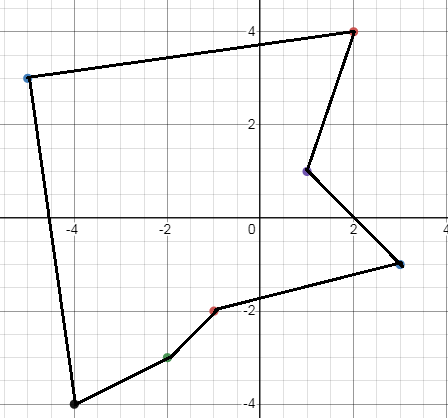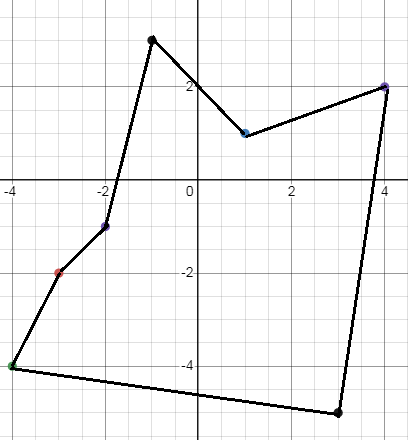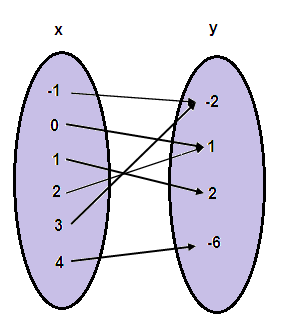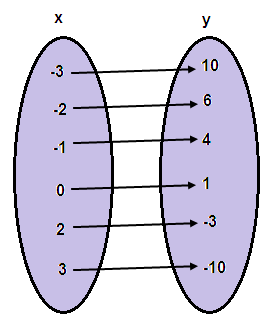FINDING INVERSE FROM THE GIVEN ORDERED PAIRS
Subscribe to our ▶️ YouTube channel 🔴 for the latest videos, updates, and tips.
To find inverse from the given set of ordered pairs, we have to follow the procedure given below.
Step 1 :
The given set of ordered pairs will be in the form (x, y)
Let R = {(1, a) (2, b) (3, c)}
Step 2 :
Exchange the values of x and y.
R-1 = {(a, 1) (b , 2) (c, 3)}
Step 3 :
Relationship between function and its inverse.
Domain of function = Range of inverse function
Range of function = domain of inverse function
How to check if the function will have inverse ?
The function which is one to one, then it will have inverse function.
Find the inverse for each relation.
Problem 1 :
{(1, -3), (-2, 3), (5, 1), (6, 4)}
Solution:
Let R = {(1, -3), (-2, 3), (5, 1), (6, 4)}
R-1 = {(-3, 1), (3, -2), (1, 5), (4, 6)}
Problem 2 :
{(-5, 7), (-6, -8), (1, -2), (10, 3)}
Solution:
Let R = {(-5, 7), (-6, -8), (1, -2), (10, 3)}
R-1 = {(7, -5), (-8, -6), (-2, 1), (3, 10)}
In each problem, find the inverse of the function then graph both the function and its inverse.
Problem 3 :
f(x) = (2, 4) (-5, 3) (-2, -3) (1, 1) (-4, -4) (-1, -2) (3, -1)
f-1(x) =
Solution:
f(x) = (2, 4) (-5, 3) (-2, -3) (1, 1) (-4, -4) (-1, -2) (3, -1)
f-1(x) = (4, 2) (3, -5) (-3, -2) (1, 1) (-4, -4) (-2, -1) (-1, 3)
f(x) :

f-1(x) :

Problem 4 :
h(x) = (0, 0) (-2, 4) (-1, -4) (2, 2) (-3, -3) (-4, 4) (1, -1)
h-1(x) =
Solution:
h(x) = (0, 0) (-2, 4) (-1, -4) (2, 2) (-3, -3) (-4, 4) (1, -1)
h-1(x) = (0, 0) (4, -2) (-4, -1) (2, 2) (-3, -3) (4, -4) (-1, 1)
h(x) :

h-1(x) :

Does the function have an inverse function?
Problem 5 :

Solution:
The inputs -1 and 3 are associated with -2.
From the arrow diagram, it is clear

different inputs are giving the same output. So, it is not one to one.
Problem 6 :

Solution:
Each input is having different output.

So, it is one to one.
Use the table of values for y = f(x) to complete a table for y = f-1(x).
Problem 7 :

Solution:
f-1(x) :
|
x -2 0 2 4 6 8 |
y -2 -1 0 1 2 3 |
Problem 8 :

Solution:
f-1(x) :
|
x -10 -7 -4 -1 2 5 |
y -3 -2 -1 0 1 2 |
Problem 9 :
The function given by f(x) = k(x3 + 3x - 4) has an inverse function, and f-1(-5) = 2. Find k.
Solution:
Given, f(x) = k(x3 + 3x - 4)
Since the inverse of f(x) exists and f-1(-5) = 2,
then f(2) = -5
Put x = 2 in the function f(x) = k(x3 + 3x - 4)
f(2) = k(23 + 3(2) - 4)
-5 = k(8 + 6 - 4)
-5 = 10k
k = -1/2
Problem 10 :
Think About It The function given by f(x) = k(2 - x - x3) has an inverse function, and f-1(3) = -2. Find k.
Solution:
Given, f(x) = k(2 - x - x3)
Since the inverse of f(x) exists and f-1(3) = -2,
then f(-2) = 3
Put x = -2 in the function f(x) = k(2 - x - x3)
f(-2) = k(2 - (-2) - (-2)3)
3 = k(2 + 2 + 8)
3 = 12k
k = 1/4
Problem 11 :
Your wage is $8.00 per hour plus $0.75 for each unit produced per hour. So, your hourly wage in terms of the number of units produced is
(a) Find the inverse function.
(b) What does each variable represent in the inverse function?
(c) Determine the number of units produced when your hourly wage is $22.25.
Solution :
x be the number of units he works
Required wages y = 8 + 0.75x
a) The required function is
y = 8 + 0.75x
Inverse function.
Exchange x and y
x = 8 + 0.75y
Solve for y,
x - 8 = 0.75y
y = (x - 8)/0.75
f-1(x) = (x - 8)/0.75
In the original function x represents hours and y represent wages.
b) In the inverse function x represents wages and f-1(x) represents number of hours.
(c) f-1(x) = (22.25 - 8)/0.75
f-1(x) = (22.25 - 8)/0.75
= 14.25/0.75
f-1(x) = 19 units
Problem 12 :
You need a total of 50 pounds of two types of ground beef costing $1.25 and $1.60 per pound, respectively. A model for the total cost of the two types of beef is where is the number of pounds of the less expensive ground beef.
y = 1.25x + 1.60(50 - x)
(a) Find the inverse function of the cost function. What does each variable represent in the inverse function?
(b) Use the context of the problem to determine the domain of the inverse function.
(c) Determine the number of pounds of the less expensive ground beef purchased when the total cost is $73.
Solution :
a) y = 1.25x + 1.60(50 - x)
y = 1.25x + 80 - 1.60x
y = -0.35x + 80
y = 80 -0.35x
x be the number of pounds of beef and y be the total cost.
Inverse function :
x = 80 - 0.35y
Solving for y,
0.35y = 80 - x
y = (80 - x)/0.35
f-1(x) = (80 - x)/0.35
b) Here x be the total cost and f-1(x) number of pounds of beef.
c) Total cost = 73
73 = 80 -0.35x
0.35x = 80 - 73
0.35x = 7
x = 7/0.35
x = 20
When number of pounds of beef is 20, the cost will be $73.
Subscribe to our ▶️ YouTube channel 🔴 for the latest videos, updates, and tips.
Recent Articles
-
Finding Range of Values Inequality Problems
May 21, 24 08:51 PM
Finding Range of Values Inequality Problems -
Solving Two Step Inequality Word Problems
May 21, 24 08:51 AM
Solving Two Step Inequality Word Problems -
Exponential Function Context and Data Modeling
May 20, 24 10:45 PM
Exponential Function Context and Data Modeling